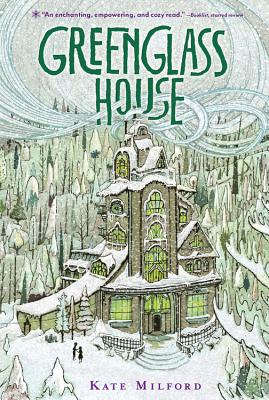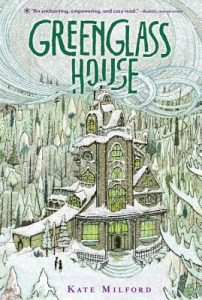craft review by Kat St. Claire
Like a British Cozy mystery, Kate Milford’s tale about an inn filled with guests hiding secrets guides the reader to the final answer, with plenty of questions and misdirection. Milo, the adopted son of the inn’s owners, must discover these secrets to solve the mysteries that surround the inn and its past. As he and the cook’s daughter Meddy uncover the secrets of the house, the process also reveals secrets about Milo himself.
From pacing to setting to characters, this novel offers inspiration for middle grade writers.
**Note: This craft review includes spoilers.**
The Slow Reveal
Here’s the biggest spoiler: Meddy turns out to be a ghost, the daughter of the captain who built the house. Milo doesn’t know this until late in the novel—and doesn’t know that others don’t see her. Every time Meddy shows up in the book, she’s sort of hiding–behind the Christmas tree, behind the loveseat. Milo is mostly alone when they are together. But the author is so natural with her description of Meddy’s whereabouts that it wasn’t until I realized she was a ghost that I took notice of her odd behavior.
Milford threads clues about Meddy’s identity into the story, as when Meddy suggests she and Milo play a role-playing quest game. She wants her character to be a winged creature called a scholiast, an angel’s familiar that doesn’t get to have adventures. Meddy wants to be a scholiast who has an adventure, even though she’s not supposed to. But she’d have to be invisible, she says. To everyone but Milo.
This clue and others set the story up to make sense in the end, but aren’t so obvious that the reader figures things out ahead of time.
Action: Reread a middle grade mystery. Pay attention to where the author places clues. In your own work, ask yourself if you’re revealing enough or not enough. On your plot outline, mark the clues you leave over the course of the story.
Unconventional Friendships
Greenglass House is a smuggler’s inn, the clientele questionable. But Milo befriends these eccentric guests of dubious occupation. Milo’s parents seem to be okay with these unconventional friendships. This fact gave me a sense of freedom to explore outside what would seem permissible for kids in real life.
Action: Are you playing it safe with whom your main character interacts? Where can you take risks?
Setting as Obstacle
Greenglass House’s setting contributes to the story and moves it forward. The difficulty of getting to the inn situated on the side of a steep hill above a river adds to the elements of secrecy and mystery. Guests have to travel by boat, then up a rickety cable railway, or climb up the steep 310 steps. And harsh weather in the area makes the Greenglass House even more difficult to reach. The remote location isolates the characters, as if they are marooned on this precipice. This adds to the tension, a sense that no outside forces would be able to save the day.
Action: Can your setting create natural obstacles for your main character or other characters? Can it add to the conflict as well as create a mood for the story?
Strong Character Motivation
Everyone who arrives at the Greenglass House has a strong motivation to do so. Each character carries a piece of the puzzle, a reason for being there that is personal to them but also part of the whole, the historical and functional aspects of the story. For instance, the elderly woman, Mrs. Hereward, clutches an embroidered bag. What is that picture sewn into it? Does it hold clues to the mansion’s past?
Milford had a challenge in including so many characters. Like Mr. Vinge with his penchant for colorfully patterned socks who seems pleased about getting snowed in at a remote lodge. Or the young woman, Clem, who prefers to sprint up the 310 outside steps–and the five flights of stairs inside the old mansion inn–to keep in shape for her profession (cat burglary?). As in any mystery, all the characters needed to seem uniquely important without overloading the story with unnecessary circumstances and backstory.
Again, these are questions we each face in developing our own stories: How much is too much? When and where can we trim to allow the story to unfold in its best and clearest light? How can we keep from burying the important truths of the story in decoration?
Action: Do your characters really need to do what they do? Do their actions carry the arc of the story through to its high point and then to the end? Do any two characters serve the same purpose? If so, can you combine the characters or eliminate one?
Kat St. Claire writes in her downtown Menlo Park treehouse where traffic sounds like ocean waves and imagination reigns. Her fiction and poetry for children have received a number of awards and publications. Kat is currently working on a middle grade novel/series. She is a member of SCBWI, loves the MG Lunch Break book discussion group, and is pleased to be included in the Kidlit Craft blog.
Find her on Facebook at Kat St. Claire-Writer and on her web site, katstclaire.com.



COMMENTs:
0